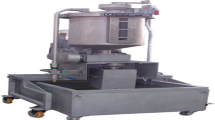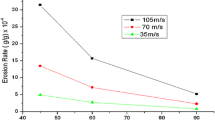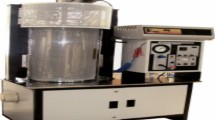Abstract
Superalloys such as Ti-31 and Superco-605 are extensively used material for gas-turbine component. Most of these gas-turbine components such as compressors, blades and vanes work under very high temperature condition. The residue results after combustion of fuel consists of solid particles such as coal ash and unburned carbon particle. These solid particles travelling at very high speed when hit the component lead to the erosion wear. The damage caused to the component due to erosion wear has significant effect on the service life of the component. Thus, in present investigation effort has been made to conduct solid particle erosion wear test on Ti-31 and Superco-605 superalloys. The test was conducted as per ASTM G76 standard with the help of Air jet Erosion test rig. The test was performed at an air pressure of 1 Bar at different impact angles of 30°, 60°, and 90°. Steady state volumetric rate of erosion is calculated to analyse the erosion under different impact angles. Further, micrograph of eroded surface was taken using scanning electron microscope to analyse the mechanism of material removal. From the result, it was observed that loss of material is higher in Superco-605 in comparison to Ti-31 superalloy. Micrograph reveals that in case of Superco-605, the material removal takes place mainly through brittle fracture whereas ductile mode of erosion was observed in case of Ti-31 superalloy.
Access provided by Autonomous University of Puebla. Download conference paper PDF
Similar content being viewed by others
Keywords
1 Introduction
Solid particle erosion has been reported as the cause of material degradation in many mechanical systems, such as aircraft gas turbines, thermal power plants, industrial waste incinerators, and many others[1], and superalloys have been found to be a better option for the components of mechanical systems that will be exposed to severe material degradation conditions, as it has been a major concern in recent research topics. From the observations made in the literature, there are mainly two categories of erosion mechanisms, namely brittle and ductile erosion, and they are further classified as deformation mechanisms and cutting mechanisms [2,3,4]. Under oblique impact conditions, the cutting mechanism is the most effective mode of erosion, whereas, under normal impact conditions, the deformation mechanism is the major cause of the erosion [5]. The effectiveness of each of the mechanisms is directly proportional to the tangential and normal components of the impact energy of the erodent, which also depends on the angle of impact [6]. Many parts of the turbine are likely to be subjected to intense mechanical and thermal loads; they will also be exposed to erosion. Hence, for a single material, it would be tough to cope with the desired properties. Hence, composite material is the best solution for satisfying demanding requirements [7,8,9,10]. Prashanth Kumar Singh et al. used a detonation gun spray technique to coat SAE213-T12 boiler steel with WC-12CO, Stellite 21, and Stellite 6 coatings, and then tested them for solid particle erosion. The cobalt component of the coating was revealed to play a significant influence in erosion resistance, with Stellite 21 and Stellite 6 coatings exhibiting 50 to 60% greater erosion resistance than WC–Co [1].
Aravind Nagaraj et al. [11] reported studies on solid particle erosion of the nickel-based superalloy CY5SnBiM at particle velocities of 59, 92, and 124 m/s and at four different angles of impact, namely 30°, 45°, 60°, and 90°. The results show that the mode of erosion is ductile, with deep pits and craters formed by rebounding erodent particles at higher angles of impact. Mustafa Kaplan et al. [12] in an investigation reported the erosion behaviour of Inconel718 superalloy using two different coatings: CoNiCrAlY and ZrO2 + 8% Y2O3. Following the air jet erosion test, it was discovered that the largest erosion rate occurred at a 60° impact angle, indicating a semi-ductile/semi-brittle mode of erosion. Mayank Patel et al. [13] reported solid particle erosion investigations of boiler tube steel SS304 at room temperature with alumina of size 50 m, impact velocity of 40 m/s, and impact angles of 30° and 90°. And results indicate the erosion rate is higher at 30° angle of impact than at 90° confirming the ductile mode of erosion. SB Mishra et al. [14] in a study employed three types of coatings on Nickel based superalloys in their study: NiCrAlY, Ni-20Cr, and Ni3Al, and subjected them to solid particle erosion tests. The results showed that the coating Ni3Al had the lowest rate of erosion at 30° and 90° angles of impact. The coating Ni-20Cr has the highest rate of erosion.
Shibe et al. [15] investigated the erosion properties of three distinct coating types, including WC-12%CO, Cr3C2-25%NiCr, and Al2O3-13%TiO2, on ASTM36 steel and uncoated ASTM36 steel, and found that all three types of coatings were effective in protecting the base metal from solid particle erosion at 45° impact angles, while WC-12%CO, Cr3C2-25%NiCr coatings were effective in protecting the substrate. Sidhu et al. [16] investigated the erosion behaviour of bare and HVOF spray coated boiler tube steel (GrA1) at 250 °C and results indicate that the coating's hardness is better than bare steel, and that the coating's material loss is greater than uncoated boiler tube steel. Pauzi et al. [17] reported the wear effects in hot-gas-path components and different hard face coatings are discussed in depth. Wear is identified as a major issue in gas-turbine hot-gas-path components. Erosion-resistant coatings, especially on turbine blades, may extend the life of hot-gas-path components. In the present work, an attempt has been made to compare and evaluate the solid particle erosion behaviour of special alloy Ti-31 and Superco-605 superalloy.
2 Experimental Details
2.1 Superalloy Materials
In present experimental work, Superco-605 (a cobalt based superalloy, ASTM B338 grade 5) and Ti-31 (ASTM 9009) superalloy are chosen as the workpiece material. The material was procured from Mishra Dhatu Nigam Limited (MIDHANI), Hyderabad, India. The material is selected due to its extensive application in the manufacturing of turbine components which demands a very high resistance to erosion wear. The chemical composition of the material is given in Table 1. The material was cut in the dimension of 25mmW × 5mmH × 25 mmL to perform the experiment.
2.2 Solid Particle Erosion Test
The erosion test is carried out as per ASTM G76 standard with the help of Air jet Erosion rig shown in Fig. 1. The process parameter used to perform the test is listed in Table 2. To start, the sample is first cleaned using acetone to remove any dirt and dust. Using an electronic weight balance (accuracy: 0.001gm), the sample's initial weight is recorded. The sample is then located in the test rig's sample holder. The erosion test is performed at different impact angles 30°, 60°, and 90° with constant particle velocity of 40 m/s. The pressure of air jet was maintained to 1 bar throughout the test. After each cycle of operation, the weight loss and cumulative weight are recorded. This procedure is repeated until the erosion rate reaches to a steady state. From the recorded data, the following formulas are used to compute erosion rate and steady state volumetric erosion rate.
Erosion rate (g/g) = Cumulative weight loss of sample/ Mass of erodent
Steady state volumetric rate of erosion (cm3/g) = Average of erosion rate/ Density
3 Results and Discussion
3.1 Studies of Erosion Mechanism of Ti-31
Figure 2 shows an optical micrograph of the scar formed by erosion of a Ti-31 sample at various impact angles. The enclosed region of the micrograph depicts the material loss on account of erosion which is immediately followed by elastically loaded material zone. Figure 2 shows the erosion rate and steady state volumetric erosion rate graphs. Figure 2a shows an increasing erosion rate at a 30° impact angle and a minimum at a 90° impact angle, Similarly, as demonstrated in Fig. 2b, steady state volumetric erosion rate is highest at 30° and lowest at 90° angle of impact, which is the trend generally observed in materials that exhibit ductile mode of erosion. The variation in erosion rate with cumulative mass of erodent is shown in Fig. 3a. Also, the variation in steady state volumetric rate of erosion at different impact angles is shown in Fig. 3.
3.2 SEM/EDS Analysis
The SEM micrograph of the encircled region is taken to depict the mechanism of material removal involved in the erosion process and is shown in Fig. 4. SEM micrographs of scars developed on Ti-31 samples due to erosion at a 30° impingement angle are shown in Fig. 4a, and material removal is seen as actions like ploughing, formation of loose debris, and grooves. SEM images of the erosion scar obtained on special alloy Ti-31 for a 60° impingement angle are shown in Fig. 4b, and material removal is seen as ploughing and crater formation, and the crater is formed when embedded sand particles are dropped from the surfaces. When the samples are subjected to erosion at a 90° angle of impact, the micro structural features are as shown in Fig. 4c. It is obvious from the micro graph that ploughing action, erodent entrapment, and groove development occur. EDS examination (ref Fig. 5) on the erosion scar developed on a sample subjected to erosion at 30° impact angle reveals that on the surface there is 46.01 wt % Ti as the major phase and 10.45% of C, 4.85% Al as minor constituents, and the presence of 7.59% Si confirms the entrapment of sand particles in the substrate.
3.3 Erosion Behaviour of Superco-605 Superalloy
Figure 6a–c shows photographs of the erosion scar generated on the Superco-605 sample at 30°, 60°, and 90° impedance angles, respectively. The eroded scar's middle (A) symbolises a limited zone of material deterioration that is surrounded by an elastic loading area B). The erosion rate and steady state volumetric erosion rate are calculated; Fig. 7 shows the erosion rate curves as well as the steady state volumetric erosion rate bar chart. The steady state volume erosion rate is found to be greatest at 90° impact angles and lowest at 30° impact angles (Fig. 6b). This is the typical behaviour of materials that have a brittle mode of erosion.
3.4 SEM with EDS Analysis
The scar generated on uncoated Superco-605 at a 30° impact angle is shown in micro structural detail in Fig. 8a. Ploughing, debris trapping, and groove creation are all visible damage in the microstructure. Similarly, Fig. 8b depicts microstructure features in a scar created by a 60° impact angle, which reveals material degradation in the form of ploughing, groove creation, and craters. Craters may occur when erodent particles are dislodged from their entrapment. Micrographs of material damage at a 90° erodent impact angle are shown in Fig. 8c. Ploughing causes material degradation, crater creation, and erodent particle trapping. EDS analysis (refer to Fig. 9) of the erosion scar on a sample that was eroded at a 30° impact angle shows that the surface contains 50.96 wt.% Co as the major phase, 19.45 wt.% C, 17.79 wt.% Cr as minor constituents, and 10.45wt.% Si, which shows that sand particles have been trapped in the substrate.
4 Conclusions
-
1.
In the instance of Ti-31, erosion is higher at 30 degrees and less at 90 degrees. This is the typical behaviour of material that erodes in a ductile mode.
-
2.
The erosion rate of Superco-605 is greater at 90° and lower at 30° angle of contact, indicating that the mechanism of erosion is brittle.
-
3.
Material loss in the form of ploughing, groove, and crater development can be seen in SEM micrographs of eroded samples of Ti-31 and Superco-605.
-
4.
EDS analysis reveals silica sand particle penetration into the substrate, followed by crater formation as a result of entrapped sand particle drop-off from the substrate.
References
Singh PK, Mishra SB (2020) Erosion performance of detonation gun deposited WC–12Co, Stellite 6 and Stellite 21 coatings on SAE213-T12 steel. Tribol-Mater Surf Interfaces 14(4):229–239
Kablov EN, Muboyadzhyan SA (2017) Erosion-resistant coatings for gas turbine engine compressor blades. Russian Metallurgy (Metally) 6:494–504
Anand Babu, K, N Jagadeeswaran, Kapilan N, Ramesh M R (2020) Improved erosion resistance by HVOF sprayed 10% Al2O3-COCrAlTaY coating on Ti-31. IJRTE 8:1605–1610
Vinod Kumar MS, Suresh R, Jegadeeswaran N (2021) Study of solid particle erosion behavior of HVOF spray coated superco-605 superalloy. Mater Today: Proc 45:10–14
Thirugnanasambantham KG, Natarajan S (2015) Degradation through erosion: mechanistic studies on IN-718 superalloy under hot air jet conditions. J Mater Eng Perform 24(7):2605–2613
Zhao J-R, Hung F-Y, Lui T-S (2019) Erosion resistance and particle erosion-induced tensile embrittlement of 3d-selective laser melting inconel 718 superalloy. Metals 10(1):21
Bircan B, Fidan S, Çimenoğlu H (2014) Solid particle erosion behavior of Inconel 718 super alloys under elevated temperatures. J Achieve Mater Manuf Eng 66(1):5–12
Jappes JTW et al (2022) Numerical analysis of 3D printed Inconel 718 superalloy for mechanical properties and solid particle erosion studies. Mater Today: Proc 52:239–245
Levin BF, Dupont JN, Marder AR (1998) Solid particle erosion resistance of ductile wrought superalloys and their weld overlay coatings. J Mater Sci 33(8):2153–2163
Kumar D, Npandey K (2021) A comparative study of erosion wear rate of conventional and nonconventional thermal barrier coatings on IN800 superalloys. Sādhanā 46(3):1–17
Aravind Nagaraj T, Kumaresh Babu SP, Vallimanalan A, Srinivasan SA, Mahendran R (2019) Solid particle erosion behavior of cast CY5SnBiM at room temperature. J Inst Eng-India 100:91–96
Kaplan M, Uyaner M, Avcu E, Yildiran Avcu Y, Karaoglanli AC (2019) Solid particle erosion behavior of thermal barrier coatings produced by atmospheric plasma spray technique. Mech Adv Mater Struct 261:606–1612
Patel M, Patel D, Sekar S, Tailor PB, Ramana PV (2016) Study of solid particle erosion behaviour of SS 304 at room temperature. Procedia Technol 23:288–295
Mishra SB, Prakash S, Chandra K (2006) Studies on erosion behaviour of plasma sprayed coatings on a Ni-based superalloy. Wear 260(4–5):422–432
Shibe V, Chawla V (2019) Erosion studies of D-Gun-Sprayed WC-12% Co,Cr3C2–25% NiCr and Al2O3–13% TiO2 coatings on ASTM A36 steel. J Therm Spray Technol 28(8):2015–2028
Sidhu HS, Sidhu BS, Prakash S (2007) Solid particle erosion of HVOF sprayed NiCr and Stellite-6 coatings. Surf Coat Technol 202:232–238
Pauzi AA et al (2020) Wear characteristics of superalloy and hard face coatings in gas turbine applications–a review. Metals 10(9):1171
Acknowledgements
The authors would like to thank NIE Mysore for providing an Air Jet Erosion Test rig for conducting solid particle erosion investigations, as well as Vignyana Bhavan University of Mysore for providing SEM/EDS.
Author information
Authors and Affiliations
Corresponding author
Editor information
Editors and Affiliations
Rights and permissions
Copyright information
© 2024 The Author(s), under exclusive license to Springer Nature Singapore Pte Ltd.
About this paper
Cite this paper
Vinod Kumar, M.S., Suresh, R., Jagadeeswaran, N., gowda, B. (2024). Study of Solid Particle Erosion Behaviour of Uncoated Superalloys of Turbine Application. In: Velmurugan, R., Balaganesan, G., Kakur, N., Kanny, K. (eds) Dynamic Behavior of Soft and Hard Materials, Volume 3. IMPLAST 2022. Springer Proceedings in Materials, vol 36. Springer, Singapore. https://doi.org/10.1007/978-981-99-6259-4_20
Download citation
DOI: https://doi.org/10.1007/978-981-99-6259-4_20
Published:
Publisher Name: Springer, Singapore
Print ISBN: 978-981-99-6258-7
Online ISBN: 978-981-99-6259-4
eBook Packages: Chemistry and Materials ScienceChemistry and Material Science (R0)













